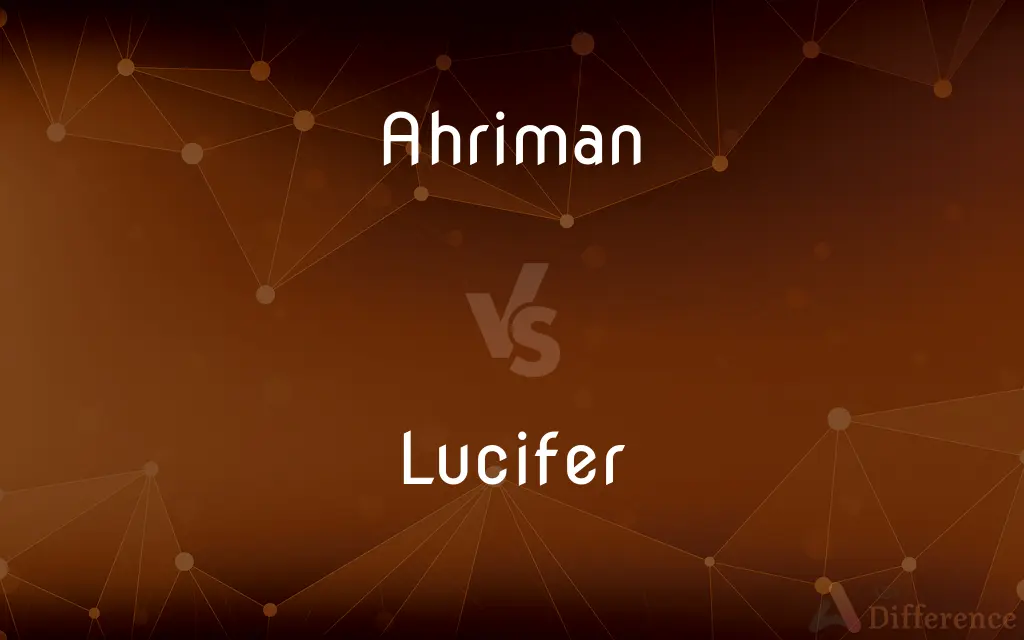Ahriman vs. Lucifer — What's the Difference?
By Maham Liaqat & Fiza Rafique — Updated on March 27, 2024
Ahriman represents destructive forces in Zoroastrianism, while Lucifer, often linked to Satan, embodies rebellion and pride in Christian tradition.

Difference Between Ahriman and Lucifer
Table of Contents
ADVERTISEMENT
Key Differences
Ahriman, according to Zoroastrianism, is the eternal opponent of Ahura Mazda, embodying the spirit of destruction, darkness, and evil. He is central to the dualistic nature of Zoroastrian cosmology, which pits good against evil in a cosmic battle. Lucifer, on the other hand, originates from Latin meaning "light-bringer" and is often identified with Satan in Christian tradition. This figure is associated with pride, rebellion, and the fall from grace, representing a complex symbol of defiance and enlightenment.
In Zoroastrianism, Ahriman is not just an adversary; he is essential to the religion’s core belief in the cosmic struggle between good and evil. His existence is crucial for the balance and purpose within the universe, encouraging humans to choose righteousness over evil. Whereas, Lucifer’s story, particularly his fall from Heaven as described in Christian texts, serves as a moral lesson on the dangers of pride and rebellion against divine authority.
The concept of Ahriman encompasses a broader cosmic duality where his influence is manifested in the physical world through drought, famine, and disease, challenging humans to maintain their faith and good deeds. Lucifer’s influence, contrastingly, is often portrayed as more individualistic, tempting humans away from God’s commandments and towards sin, but also symbolizing human struggle, freedom, and enlightenment in different interpretations.
Ahriman’s role is defined within a predestined cosmic order, where his eventual defeat is prophesied, highlighting the Zoroastrian optimism for the ultimate triumph of good. In Christian theology, Lucifer’s fate is also sealed, with his rebellion leading to eternal damnation, reflecting a theological narrative of justice and redemption.
The portrayal of Ahriman and Lucifer across cultures and literature has varied, with Ahriman embodying the essence of pure evil within a dualistic framework, while Lucifer has been depicted in a more nuanced manner, sometimes even eliciting sympathy or representing a quest for knowledge and autonomy.
ADVERTISEMENT
Comparison Chart
Origin
Zoroastrianism
Christian tradition
Represents
Destruction, evil, darkness
Rebellion, pride, enlightenment
Cosmic Role
Opponent of Ahura Mazda, embodies evil
Fallen angel, symbol of defiance
Influence on Humanity
Tempts towards evil, manifests as physical calamities
Tempts towards sin, represents individual struggle
Symbolism
Cosmic duality, eternal battle between good and evil
Moral fall, quest for knowledge, autonomy
Ultimate Fate
Defeat and destruction prophesied
Damnation, but also enlightenment in some interpretations
Cultural Representation
Pure evil, part of a cosmic order
Complex, varies from evil to misunderstood
Compare with Definitions
Ahriman
A principal figure in Zoroastrianism representing evil and darkness.
Ahriman is seen as the eternal antagonist of Ahura Mazda in Zoroastrian texts.
Lucifer
Viewed under various lights, from evil incarnate to a symbol of enlightenment.
Literary works have often depicted Lucifer as a tragic hero questioning authority.
Ahriman
Tempts humans away from righteousness and towards evil deeds.
Ahriman’s whispers are said to lead individuals astray from the path of good.
Lucifer
Represents defiance against divine authority in Christian tradition.
Lucifer’s fall from heaven is emblematic of the ultimate rebellion.
Ahriman
Central to Zoroastrian dualism, opposing good at every turn.
The battle between Ahriman and Ahura Mazda symbolizes the cosmic struggle between good and evil.
Lucifer
Some interpretations empathize with his quest for independence.
In modern narratives, Lucifer is sometimes portrayed as seeking freedom from tyrannical rule.
Ahriman
Embodies chaos, influencing the world through negative phenomena.
Natural disasters are often attributed to Ahriman’s influence in Zoroastrianism.
Lucifer
Originally denoting a bright morning star, later identified with Satan.
Lucifer was once celebrated as a symbol of dawn before his fall.
Ahriman
Unlike figures in other traditions, Ahriman lacks redeeming qualities.
In Zoroastrian lore, Ahriman is devoid of any goodness, purely embodying evil.
Lucifer
Associated with leading mankind into temptation and sin.
Lucifer’s role in the temptation of Adam and Eve highlights his influence on human disobedience.
Ahriman
Angra Mainyu (; Avestan: ????⸱??????? Aŋra Mainiiu) is the Avestan-language name of Zoroastrianism's hypostasis of the "destructive/evil spirit" and the main adversary in Zoroastrianism either of the Spenta Mainyu, the "holy/creative spirits/mentality", or directly of Ahura Mazda, the highest deity of Zoroastrianism. The Middle Persian equivalent is Ahriman ?????? (Anglicised pronunciation: ).
Lucifer
Lucifer is the name of various figures in folklore associated with the planet Venus. Originally stemming from a son of the personified dawn, the goddess Aurora, in Roman mythology, the entity's name was subsequently absorbed into Christian folklore as a name for Satan.
Ahriman
Ahura Mazda's adversary, the chief spirit of darkness and evil in Zoroastrianism.
Lucifer
(Bible) An angelic being who was cast from heaven as punishment for his rebellious pride. Lucifer is traditionally identified with Satan.
Ahriman
The Evil Principle or Being of the ancient Persians; the Prince of Darkness as opposer to Ormuzd, the King of Light.
Lucifer
The planet Venus in its appearance as the morning star. Also called Phosphorus.
Ahriman
The spirit of evil in Zoroastrianism; arch rival of Ormazd
Lucifer
Lucifer A friction match.
Lucifer
A self-igniting match, ie. one which could be lit by striking on any surface (as opposed to safety matches which only light against the material on the side of the box).
Lucifer
The planet Venus, when appearing as the morning star; - applied in Isaiah by a metaphor to a king of Babylon.
How art thou fallen from heaven, O Lucifer, son of the morning! how art thou cut down to the ground which didst weaken the nations!
Tertullian and Gregory the Great understood this passage of Isaiah in reference to the fall of Satan; in consequence of which the name Lucifer has since been applied to Satan.
Lucifer
Hence, Satan.
How wretchedIs that poor man that hangs on princes' favors! . . . When he falls, he falls like Lucifer,Never to hope again.
Lucifer
A match{1} made of a sliver of wood tipped with a combustible substance, and ignited by friction; - called also lucifer match, and locofoco, now most commonly referred to as a friction match. See Locofoco.
Lucifer
A genus of free-swimming macruran Crustacea, having a slender body and long appendages.
Lucifer
(Judeo-Christian and Islamic religions) chief spirit of evil and adversary of God; tempter of mankind; master of Hell
Lucifer
Lighter consisting of a thin piece of wood or cardboard tipped with combustible chemical; ignites with friction;
He always carries matches to light his pipe
Common Curiosities
How do Ahriman and Lucifer influence humanity?
Ahriman tempts humans towards evil and is associated with calamities, while Lucifer tempts towards sin, symbolizing the struggle between obedience and rebellion.
What does Lucifer represent?
Lucifer represents pride, rebellion, and in some interpretations, the quest for knowledge and enlightenment.
Has the perception of Lucifer changed over time?
Yes, Lucifer’s perception has evolved, with various interpretations ranging from pure evil to a misunderstood or tragic figure.
Can Ahriman and Lucifer be considered similar?
While both represent adversarial forces in their religions, their roles, symbolism, and narratives differ significantly.
Is Lucifer the same as Satan?
In Christian tradition, Lucifer is often equated with Satan, especially in the context of his fall and role as the tempter.
Who is Ahriman?
Ahriman is the embodiment of evil in Zoroastrianism, opposing the good spirit Ahura Mazda.
What is the ultimate fate of Ahriman and Lucifer?
Both are destined for defeat and damnation in their respective religions, though Lucifer’s story also carries themes of enlightenment.
Do Ahriman and Lucifer have any redeeming qualities?
Ahriman is depicted without redemption, while Lucifer’s narrative sometimes includes themes of enlightenment and autonomy.
Why is Ahriman considered pure evil?
Ahriman embodies the absolute negation of good, with no redeeming qualities, in Zoroastrian belief.
What role does dualism play in the depiction of Ahriman?
Dualism is central to Zoroastrianism, with Ahriman playing a key role in the cosmic struggle between good and evil.
What is the significance of Lucifer’s fall?
It symbolizes the consequences of pride and rebellion against divine authority.
What lessons do the stories of Ahriman and Lucifer teach?
They offer insights into the nature of evil, the importance of choice, and the consequences of rebellion and pride.
How are Ahriman and Lucifer depicted in art and literature?
Their depictions vary widely, from evil incarnate to complex figures with motives and desires.
Share Your Discovery

Previous Comparison
Eye vs. Oculus
Next Comparison
Pooling vs. PollingAuthor Spotlight
Written by
Maham LiaqatCo-written by
Fiza RafiqueFiza Rafique is a skilled content writer at AskDifference.com, where she meticulously refines and enhances written pieces. Drawing from her vast editorial expertise, Fiza ensures clarity, accuracy, and precision in every article. Passionate about language, she continually seeks to elevate the quality of content for readers worldwide.














































